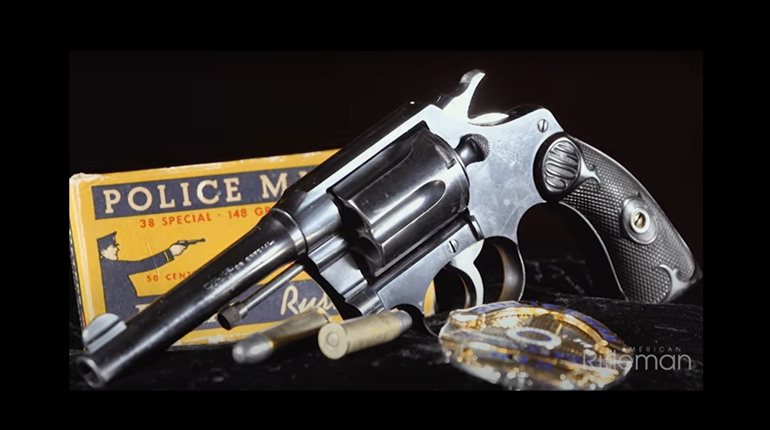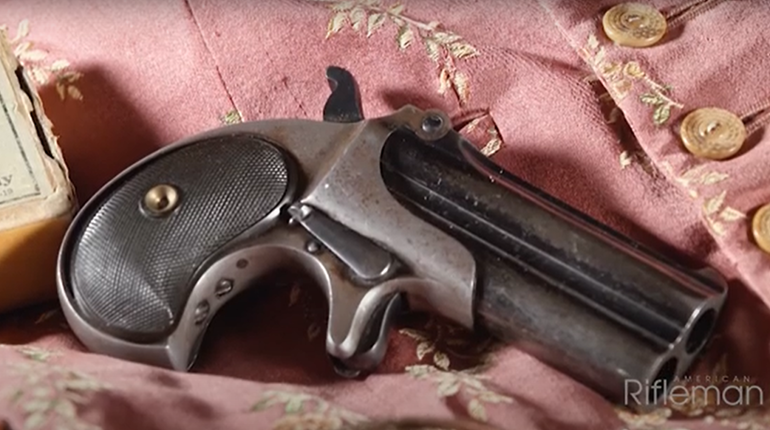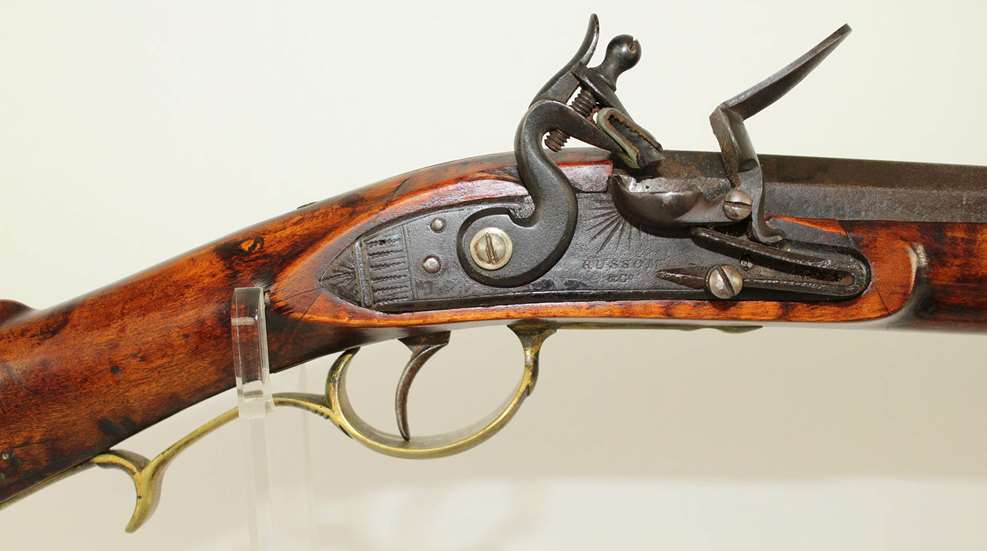
We live in an age when researching our past is common. Many companies offer DNA tests so individuals can trace their ancestry. Our cable networks and streaming services have numerous channels and programming dealing with history and antiques. One thing is for sure: Americans like learning about our past.
Firearms, too, have a very interesting beginning and evolution. Prior to modern firearms, there were six major developments in their evolution. Each generation of firearms laid the foundation for its successor. These are hand cannons, matchlocks, wheellocks, flintlocks, percussion caps and cartridge fire firearms.
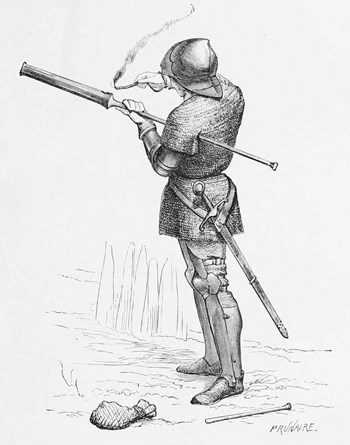 Hand Cannons
Hand Cannons
Gunpowder made its way from China to Europe in the 13th century. During that time various militaries made advances in the use of gunpowder in cannons. Eventually, these armies started experimenting with small and portable cannons that individual soldiers could operate. These hand cannons were the first firearms.
The first use of an individual firearm was recorded in 1364. This primitive firearm was no more than a crude barrel with a powder charge and projectile. The shooter lit the wick by hand, touching a hole in the barrel which ignited the gunpowder loaded into the barrel.
Advances in this first firearm eventually led to it becoming accepted by different militaries as an essential tool. In 1453, the Ottoman Turks were the first military to use firearms successfully in a siege. Firearms and cannons proved to be vital during the siege of Constantinople changing the then primitive defense systems. This was the beginning of the end for walled fortifications. 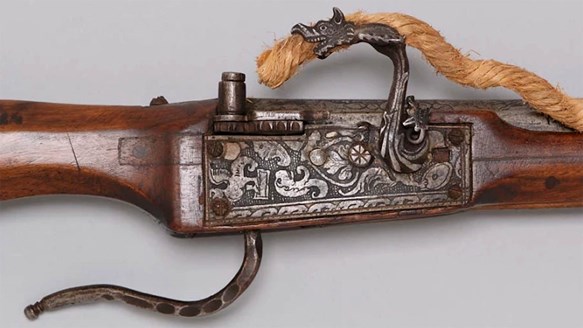
Matchlocks
Matchlock guns were the next major development in firearms. The first matchlocks appeared in the 1470s in Europe. Matchlocks differed from hand cannons in the development of the lock system. Instead of the shooter manually touching the gunpowder with a wick, a lock mechanically swung the wick forward by use of a trigger. The wicks were attached to a clamp that sprang into gunpowder that was placed in a flash pan.
There were two types of matchlock firearms: the arquebus and the musket. Both were hefty and cumbersome smoothbore firearms. The arquebus was developed in the late 1400s and had a .71 caliber bore. The musket first appeared in the early 1500s and had a .77 caliber bore.
These firearms were heavy with long barrels. Sometimes a forked staff was used to support the firearm, similar to modern-day shooting sticks. The advantage of the matchlocks was that the shooter could hold the gun with both hands while firing, allowing the shooter to better aim the firearm. Prior to matchlocks, the shooter had to hold the firearm with one hand and set the charge off with the other.

Wheellocks
Wheellock guns were developed in Europe in the mid-1500s. The wicks were replaced by the wheellock that generated a spark for igniting the gunpowder. The lock had a piece of pyrite tightened in the small clamp. The wheellock had a spring-loaded wheel that rotated when the trigger was pulled, creating sparks that landed in the flash pan. This type of lock works similar to modern lighters.
Wheellocks were a great improvement over matchlock firearms. They were more reliable and performed better in the rain and snow. Even with the advantages of this type of firearm, they never became popular. These firearms were very expensive to manufacture and very expensive to repair. Even though wheellocks never took hold, the technology helped with the development of the next generation of firearms: the flintlock.
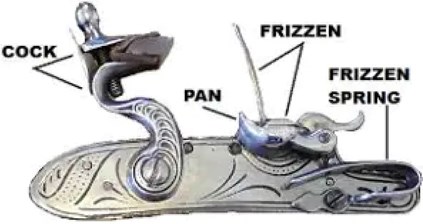 Flintlocks
Flintlocks
Flintlock guns made their first appearance in the late 1500s. By the early- to mid-1660s the flintlock had become the firearm of the world’s armies. The flintlock was the dominant firearm until the early 1800s. The development of the “frizzen” that covered the flash pan was responsible for its popularity. This made the flintlock firearm a practical gun and very reliable for the time.
Flintlocks operate opposite the way that match lock firearms did. In match locks, the wheel rotated; in flintlocks, it is the cock that rotates. The spring-loaded cock holds a small piece of flint in the clamp. When the trigger is pulled, the cock rotates forward, striking the frizzen, resulting in a shower of sparks landing in the flash pan where powder is ignited and lights the powder charge through the touch hole. The lock did two things mechanically: It opened the lid of the flash pan and provided an igniting spark.
Flintlock guns were the dominant firearms for 250 years but they did see some changes. Early flintlock rifles had smooth bores. Later flintlock rifles were rifled. The rifled firearms quickly replaced the smooth bore guns. Additionally, early flintlocks were very primitive as compared to later flintlock rifles. Because these later guns were very well constructed, they were easily converted to the new ignition system: percussion cap firearms. 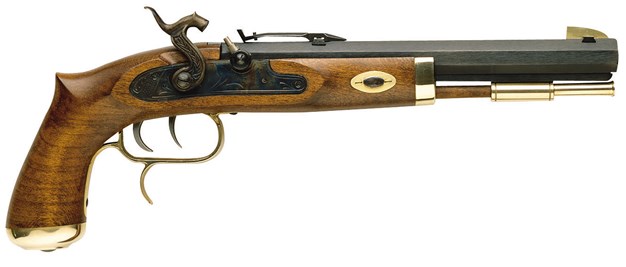
Percussion Cap Firearms
Joshua Shaw developed the first percussion cap in 1814. The lock system on this firearm was similar to flintlocks, the difference being the end of the cock. On a flintlock there was a small clamp that held the flint in place. The percussion cap cock had a small cup that encompassed the primer when fired.
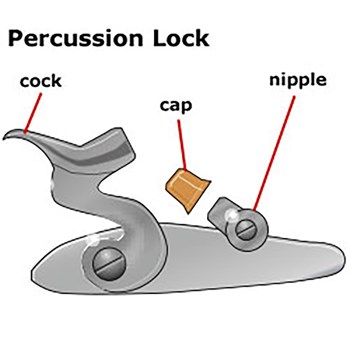 The percussion cap firearm worked by placing a percussion cap on the cone or nipple and when the trigger was pulled, the cock rotated forward landing in the percussion cap. The cap was ignited, causing sparks to be funneled down the cone, which ignited the powder charge and sent the projectile down the barrel. The percussion system was simple and not as expensive to produce as previous firearms. As a result, many flintlock firearms were refitted and converted to percussion cap firearms.
The percussion cap firearm worked by placing a percussion cap on the cone or nipple and when the trigger was pulled, the cock rotated forward landing in the percussion cap. The cap was ignited, causing sparks to be funneled down the cone, which ignited the powder charge and sent the projectile down the barrel. The percussion system was simple and not as expensive to produce as previous firearms. As a result, many flintlock firearms were refitted and converted to percussion cap firearms.
The percussion cap firing system was a clean and very reliable ignition system. By 1825, percussion cap firearms became common. By 1835, Colt developed the first mass produced multi-shot revolver. Once firearms began to be mass produced, the price came down, making them more affordable.
Cartridge Firearms
The first full rimfire cartridge was developed in 1859. By the end of the Civil War, firearms firing self-contained cartridges were commonplace. Cartridge firearms are operated by squeezing the trigger which releases the firing pin. The firing pin then strikes the primer of the self-contained cartridge which ignites the gunpowder and sends the projectile down the barrel.
The development of self-contained cartridges paved the way for modern firearms. There have been changes in propellants, but the ignition system has basically stayed the same. When smokeless powder was developed, firearms designed to shoot cartridges made of black powder became obsolete. This is because modern smokeless powder creates higher pressures. Outside of stronger metals used in the production of firearms designed to shoot smokeless powder, firearms stayed relatively the same.
There have been many advances in firearms since the development of self-contained cartridges. From the days of locks, developments in firearms include bolt action, lever action, break action, slide action, semi-automatic actions and full-automatic actions.














